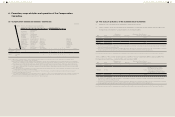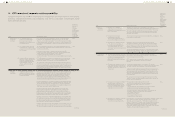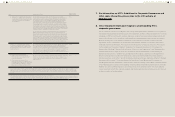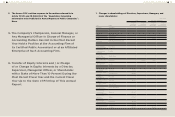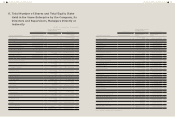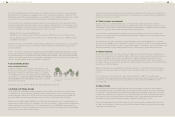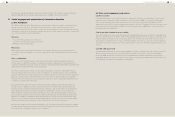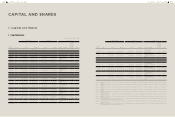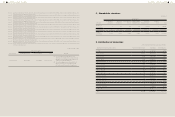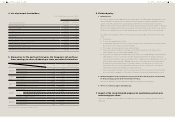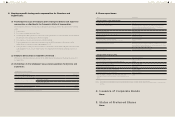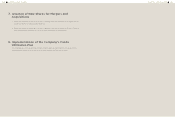HTC 2013 Annual Report Download - page 52
Download and view the complete annual report
Please find page 52 of the 2013 HTC annual report below. You can navigate through the pages in the report by either clicking on the pages listed below, or by using the keyword search tool below to find specific information within the annual report.
CORPORATE GOVERNANCE CORPORATE GOVERNANCE
100 101
HTC joined the Electronic Industry Citizenship Coalition (EICC) in December, 2012, and drew up the
HTC Supplier Code of Ethics based on the EICC. Apart from requiring suppliers to sign the Supplier
Code of Ethics, HTC also introduced CSR conformity audits for high-risk suppliers in accordance with
the "HTC Supplier Code of Ethics" and relevant regulations governing supplier factories. The audits
cover labor rights, labor conditions, environment, safety and health, integrity and ethics as well as
the operation of related management systems. Apart from on-site audits, the HTC audit team plays
the role of consultant as well. Suppliers are provided with the latest information on labor conditions,
environment, safety and health in the hopes of elevating them to first-rate sustainable suppliers.
In 2012, the issue of conflict minerals was introduced to our supplier CSR audits. On the purchase
of mineral ores, HTC supports the use of non-conflict minerals. HTC and our suppliers do everything
possible to ensure that metals such as Gold (Au), Tantalum (Ta), Tin (Sn) and Tungsten (W) used by
HTC do not come from mines located in the conflict region of the Congo Republic.
HTC supports the U.S. "Dodd-Frank Wall Street Reform and Consumer Protection Act" (H.R. 4173). We
have also joined the joint mining task force setup by the EICC as well as the Global e-Sustainability
Initiative (GeSI), and plan to participate in the EICC/GeSI conflict-free smelter program. At HTC,
we require suppliers to conform with our conflict mineral purchasing policy and reduce the use of
conflict minerals. HTC requires suppliers to sign "Mineral Source Survey" and "Declaration of Non-
Use of Conflict Minerals" documents. These requirements are explicitly defined in our supplier CSR
management process.
According to a report by the Friends of the Earth (FoE), tin mining on Indonesia's Bangka Island has
damaged human rights and the environment. HTC conducted an investigation of our tier-1 supply
chain in response to this international environmental movement and found that while there was no
direct use, there were some indirect sources that came from the tin mine on Bangka Island.
We will therefore accept the responsibility for supply chain management and require our suppliers
to avoid its use. Indonesia however is a major supplier of tin ore and complete non-use may not be
avoidable. HTC has now taken action by requiring suppliers to sign declarations of non-use. Even if
they do use ore from tin mines on Bangka Island, it must be from mines that do not exploit workers,
use child labor or cause environmental damage. HTC is committed to taking responsibility for helping
to fix the devastating impact on the environment and people caused by tin mining in order to ensure
the sustainable development of the environment.
HTC will continue to push for responsible ore purchasing and look forward to our suppliers
communicating our conflict free minerals purchasing policy to upstream suppliers.
4. Environmental protection
4.1 Green products
HTC's approach to the development of sustainable products goes beyond compliance with relevant
regulations. We also take the product's design phase into account. From product proposal, planning,
R&D and design, prototyping, engineering, pilot production, mass production through to scrapping,
a complete lifecycle assessment is conducted to dissect the product process and help our R&D team
comprehend the complex environmental factors involved.
We hope that the mobile devices we design and manufacture will conform to consumer expectations
while also reducing their environmental impact. The Precautionary Principle is therefore used during
product design and development to choose materials with lower environmental risks and confirm that they
conform to prevailing international regulations on restricted substances. We actively strive to reduce the
use of substances harmful to the environment. Designs that improve recyclability are also used to improve
resource reuse and reduce negative environmental impact.
4.1.1 Sustainable design
HTC's current sustainable design concept for products mainly emphasize the three directions of (1)
Improved energy efficiency, (2) Recyclability, and (3) Reduction of hazardous substances. These serve to
improve the green competitiveness of products.
1) Improved energy efficiency
By applying the lifecycle concept to electronic communications products, our analysis of mobile phone
carbon footprints has found that the raw materials and manufacturing phase consume the most energy.
These phases are the main source of greenhouse gases (GHG) produced by the products. A strong
emphasis is therefore placed on energy-saving design during product development. We require all power
supplies used by HTC products to conform to international regulations governing power consumption.
All power supplies used by HTC must conform to the following international standards:
‧Energy Star (U.S.)
‧California Energy Commission (U.S.)
‧EU Code of Conduct
‧Energy-related Products (ErP)
2) Recyclability
A complete assessment and simulation of a product's recyclable design is carried out during initial
development. By dismantling the product and simulating the materials, it is possible to estimate the
product's composition and relative recycling rate. Material labeling (ISO 11469, ISO 1043), component
simplification and easy disassembly design strategies are also used to provide design strategies with
reference value for R&D to study. The design of all current HTC products conforms to existing and future
product recyclability requirements.
3) Reduction of hazardous substances
HTC put the first PDA mobile phone in the world that meets the EU RoHS Directive into mass production
in 2005. Today, all parts, modules, materials and other products shipped to HTC must conform to the
regulations governing the HTC hazardous substance list. The restrictions on substances are not only
limited to the six items monitored by RoHS but also contain international environmental regulations and
international customer controls.
4.1.2 Sustainable packaging
The packaging materials used by HTC mobile phone products are intended to guarantee the product's
safety and appearance. We have taken into account the potential environmental impact from the user
discarding the packaging once they have the product. Environmental friendliness and sustainability
therefore form the basis of HTC's efforts in packaging reduction:
1. Reduce the use of materials
2. Use of biodegradable materials
3. Printing with environmental friendly ink (soy-based ink)
4. Transport-friendly packaging design


